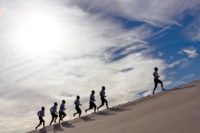Defense wins games,” is a quote you will often hear around most coaching circles of any sport. At the University of Kentucky, coach John Calipari’s teams that play the best defense usually win the most games.
The idea is simple: play as a team, prevent the other team from scoring, create turnovers, and those turnovers turn into easy transition shots. The hard part is getting teams to buy into the team vision to play selfless and trust that if they focus on all the intangibles, the scoring will come and at the end of the game the scoreboard will reflect their efforts.
Now, how do I relate all that to the current success story Siemens Wind Service has going on in Iowa with one of our largest customers? Simple, it’s about coaching a team vision, getting buy in, and asking if they will do some small but effective things. The safety record will reflect their efforts--it’s about team defense.
The challenge
When one of Siemens’ largest wind service customers challenged us to improve our safety record, we took action to make a change. The management team in Iowa looked for fresh perspectives and a new approach to get our safety record back on track. The operations team reached out to the EHS department to ask for some new ideas for a strategy to develop a recovery plan. The thought among the team was that they had tried everything else. We only had opportunity to improve from here. The result was the rollout of the Resilience Leadership Program for wind services.
The plan
The plan was simple and designed around basic concepts from the study of resilience engineering: train the people, coach the people, and support them with good systems.
- First, give people training with tools and management systems that help them Anticipate, Monitor, Respond, and Learn the risks and hazards associated with daily tasks.
- Second, teach them how to see risk and error-likely situations. Give them tools to take action to mitigate or eliminate the risk.
- Next, immerse coaches within the teams performing daily work for one-on-one contact hours to display leadership to reinforce the new expectations for learning.
- Take action when employees use the tools and systems to ask for help.
- Lastly, listen to the voices in the field for feedback to monitor if the plan is working. Make adjustments as needed to help the leadership team implement the tools and systems in the field, and provide ongoing support.
Simple human performance tools included peer check, a questioning attitude, pre-job brief, and out of procedure stop (oops). The magic happens when you harness these tools together with management systems that support their usage. The management systems that support these tools are things such as the rapid risk assessment process. This process is available 24 hours a day to aid technicians and leadership to get help to work through situations when they have no work instructions to guide their work; the work is outside of normal working conditions.
If the work is considered an elevated risk or the technician is not comfortable and sees the work as an error-likely situation, they need to ask for help to be successful. You create an entire process that works hand-in-glove; the technician sees elevated risk by using one of the human performance tools and utilizes the management system at his/her disposal to solve the problem and get back to work quickly and efficiently. The risk is mitigated, the job is completed, and an injury is avoided.
The results
The clock is still ticking, and work is still going on in Iowa. Since the rollout of the Resilience Leadership Program in Iowa there have been no recordable injuries reported in the region; near miss and safety observation reporting is some of highest of all of our regions; we have conducted rapid risk assessments at almost all sites in the region; and now the leadership at sites are asking for refresher training to keep the ball rolling.
This doesn’t mean we won’t have some challenges and setbacks in the future and need to try something new. Excellence in safety is marathon with no finish line. We are getting better, making improvements, and can identify the actions we are taking to create safety. We are not just hoping safety happens. We will continue to work hard on the small things to make the big things happen and rise to exceed the expectations of our customers.


